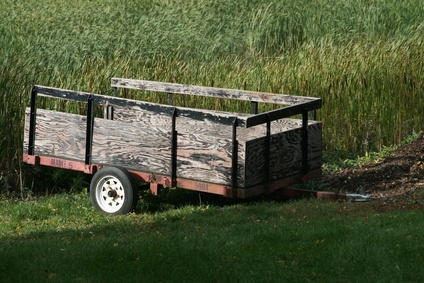
Building a small, 4-foot-by-8-foot utility trailer (the size of a standard sheet of plywood) can be relatively simple with some basic parts from a home supply store and an axle assembly from a junk car. Just be sure the final product meets all safety and road-worthiness laws and regulations where it will operate. This means brake and reverse lights connected to the tow vehicle.
The simplest frame to construct for a utility vehicle is made of 2-inch galvanized threaded pipe and "T" and elbow connectors. A rear axle assembly from a vehicle with at least a 48-inch track is needed, but a wider one may be usable. It depends on whether the trailer sits "high" above the wheels or "low" between them. Also, a sheet of plywood with a minimum 1/2-inch width is needed to floor the trailer. Two 4-foot lengths of 3/16th-inch thick angle iron will be needed. An axle bracket accessory and lighting kit from an auto-supply dealer will finish the job.
If desired, paint all material prior to assembly. Paint the galvanized paint with metal prime and then at least two top coats. Also, paint all the nuts and bolts needed. Paint the plywood sheet with wood primer, then give it two--or even more--final coats. A high-quality urethane deck paint works well for this application, although the color choices are usually limited to grey, green and rust red.
Lay out five 4-foot lengths of pipe, two feet apart. This will cover eight feet. Attach the elbow connectors to the ends of the two pipes at each end. Attach "T" connectors to the ends of the other three pipes. Use 2-foot lengths of pipe (8 total) to connect each transverse pipe. The frame is constructed.
Set the frame on top of the axle assembly and drill holes in the transverse pipes. Using the bracket accessory, attach the axle to the frame with threaded bolts. At the first transverse pipe at the front of the trailer, drill two sets of holes for attaching the angled iron, and bring the angled iron together in a "V" shape. At the apex, attach whatever trailer hitch is necessary. Drill holes in the rear transverse for attaching the light kit. Run the wires under the trailer and secure with plastic cabling straps to the frame. Bring out to the front of the trailer at the hitch for connection to the tow vehicle.
Drill holes at regular intervals in the transverse pipes. Lay the plywood sheet on top and drill holes through the wood corresponding to holes in the frame. Attach the plywood sheeting using carriage bolts. Counter-sink the holes if the trailer bed needs to be flush.